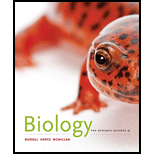
Concept explainers
Introduction:
Bacterial recombination is a type of genetic recombination in that bacterial DNA (deoxyribonucleic acid) is transferred from one bacterial cell (donor) to another bacterium (recipient) to generate genetic variability. This process takes place mainly in three ways, which are transformation, transduction, and conjugation.
Answer to Problem 1TYK
Correct answer:
The differences in the genes of bacteria can be studied by measuring the passage of genes between cells during conjugation, transduction, and transformation.
Explanation of Solution
Justification/explanation for the correct answer:
Option (e) states that the differences in genes of bacteria can be measured by the flow of genes between cells during conjugation, transduction, and transformation. The transfer of genetic information between individuals in recombination can be measured from the existence of recombinants produced from the genetic recombination. The time and order of the genes can be noted down that were transferred to the recombinants. Then, the genes can be mapped and assign in their particular positions. This can be done majorly in conjugation. Hence, option (e) is correct.
Explanation for the incorrect answer:
Option (a) states that the bacteria cannot be grown on minimal media as the media lacks essential nutrients while studying the differences in bacterial genes. The differences in the genes of the bacteria can also be studied by growing bacteria on a minimal medium for screening recombinants or conjugants. The recombinants can be differentiated from the nonrecombinants by growing them on different media, which favors them. So, it is an incorrect option.
Option (b) states that the bacterial clone, which is a group of cells from different bacteria of varying genetic make-up can be used to study the differences in bacterial genes. The passage of genes between the cells can be studied through different recombination processes. The genes in recombinants can be studied using bacterial clone, which are genetically identical cells of the same bacteria. So, it is an incorrect option.
Option (c) states that the bacterial diploid is used because of their ability to grow on minimal medium, for studying the differences in genes. Bacteria becomes partial diploid (merozygote) when recombination takes place. These are then grown on minimal media for differentiating them from nonrecombinants and to study the differences in the genes of bacteria. So, it is an incorrect option.
Option (d) states that only one genetic trait can be studied in a single recombinant event. The recipient cell or the recombinant can be tested for the presence of multiple genetic traits (multiple donor alleles) in a single recombinant event. So, it is an incorrect option.
Hence, options (a), (b), (c), and (d) are incorrect.
Therefore, it can be concluded that the differences in the genes of bacteria can be studied by measuring the passage of genes between the cells during conjugation, transduction, and transformation with the help of horizontal gene transfer determinations.
Want to see more full solutions like this?
Chapter 17 Solutions
Biology: The Dynamic Science (MindTap Course List)
- Describe the principle of homeostasis.arrow_forwardExplain how the hormones of the glands listed below travel around the body to target organs and tissues : Pituitary gland Hypothalamus Thyroid Parathyroid Adrenal Pineal Pancreas(islets of langerhans) Gonads (testes and ovaries) Placentaarrow_forwardWhat are the functions of the hormones produced in the glands listed below: Pituitary gland Hypothalamus Thyroid Parathyroid Adrenal Pineal Pancreas(islets of langerhans) Gonads (testes and ovaries) Placentaarrow_forward
- Describe the hormones produced in the glands listed below: Pituitary gland Hypothalamus Thyroid Parathyroid Adrenal Pineal Pancreas(islets of langerhans) Gonads (testes and ovaries) Placentaarrow_forwardPlease help me calculate drug dosage from the following information: Patient weight: 35 pounds, so 15.9 kilograms (got this by dividing 35 pounds by 2.2 kilograms) Drug dose: 0.05mg/kg Drug concentration: 2mg/mLarrow_forwardA 25-year-old woman presents to the emergency department with a 2-day history of fever, chills, severe headache, and confusion. She recently returned from a trip to sub-Saharan Africa, where she did not take malaria prophylaxis. On examination, she is febrile (39.8°C/103.6°F) and hypotensive. Laboratory studies reveal hemoglobin of 8.0 g/dL, platelet count of 50,000/μL, and evidence of hemoglobinuria. A peripheral blood smear shows ring forms and banana-shaped gametocytes. Which of the following Plasmodium species is most likely responsible for her severe symptoms? A. Plasmodium vivax B. Plasmodium ovale C. Plasmodium malariae D. Plasmodium falciparumarrow_forward
- please fill in missing parts , thank youarrow_forwardplease draw in the answers, thank youarrow_forwarda. On this first grid, assume that the DNA and RNA templates are read left to right. DNA DNA mRNA codon tRNA anticodon polypeptide _strand strand C с A T G A U G C A TRP b. Now do this AGAIN assuming that the DNA and RNA templates are read right to left. DNA DNA strand strand C mRNA codon tRNA anticodon polypeptide 0 A T G A U G с A TRParrow_forward
 Concepts of BiologyBiologyISBN:9781938168116Author:Samantha Fowler, Rebecca Roush, James WisePublisher:OpenStax College
Concepts of BiologyBiologyISBN:9781938168116Author:Samantha Fowler, Rebecca Roush, James WisePublisher:OpenStax College Biology: The Dynamic Science (MindTap Course List)BiologyISBN:9781305389892Author:Peter J. Russell, Paul E. Hertz, Beverly McMillanPublisher:Cengage Learning
Biology: The Dynamic Science (MindTap Course List)BiologyISBN:9781305389892Author:Peter J. Russell, Paul E. Hertz, Beverly McMillanPublisher:Cengage Learning Human Heredity: Principles and Issues (MindTap Co...BiologyISBN:9781305251052Author:Michael CummingsPublisher:Cengage Learning
Human Heredity: Principles and Issues (MindTap Co...BiologyISBN:9781305251052Author:Michael CummingsPublisher:Cengage Learning Biology Today and Tomorrow without Physiology (Mi...BiologyISBN:9781305117396Author:Cecie Starr, Christine Evers, Lisa StarrPublisher:Cengage Learning
Biology Today and Tomorrow without Physiology (Mi...BiologyISBN:9781305117396Author:Cecie Starr, Christine Evers, Lisa StarrPublisher:Cengage Learning
 Understanding Nutrition (MindTap Course List)Health & NutritionISBN:9781337392693Author:Eleanor Noss Whitney, Sharon Rady RolfesPublisher:Cengage Learning
Understanding Nutrition (MindTap Course List)Health & NutritionISBN:9781337392693Author:Eleanor Noss Whitney, Sharon Rady RolfesPublisher:Cengage Learning





